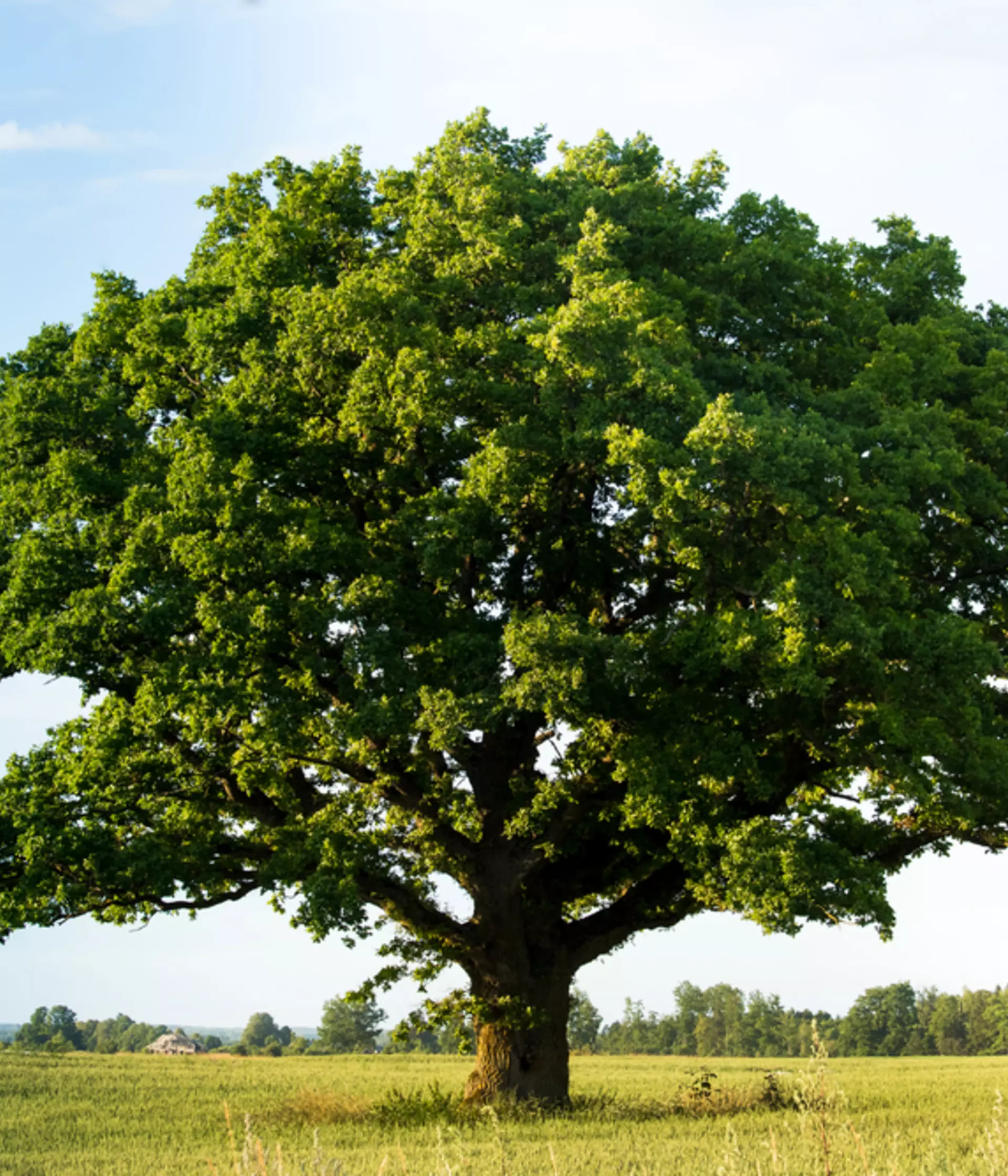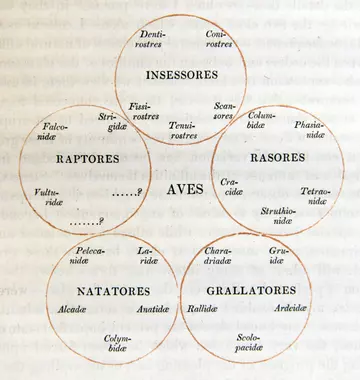
Ann Sylph, MSc, MCLIP
ZSL Librarian
'Trees of life' are a concept throughout much of human history, linking humans and the natural world.
More recently, 'trees' have adapted and changed to depict evolution and relationships in the natural world. In this blog I look at the various depictions of the 'tree of life'. As I have said in previous blogs 'a picture is worth a thousand words'. In the case of 'trees of life' they are now used to convey a large amount of information in a visual way to increase understanding and accessibility.
Long before Charles Darwin did his sketch of the tree of life 'I think' ancient civilisations had their own 'trees of life', for instance at the current British Museum exhibition Scythians : Warriors of ancient Siberia.
Quinarian classification system
Nicholas Aylward Vigors was a founder of ZSL and our first Secretary from 1826 to 1833. He supported and promoted the Quinarian classification system. Quinarians believed that the natural world was based on divisions of five.The system was devised by Macleay and is introduced in his book Horae Entomologicae (1819-20). He proposed that all groups of animals could be depicted as five circles as in Vigors depiction for the classification of birds as shown below. If a group of animals did not form five, then it was believed that it actually did but the missing groups were at that time unknown and yet to be discovered. Each group could be subdivided to a further five. To read more about the Quinarian Classification read this blog `Quirky Quinarians' 9 September 2012.

August Goldfuss used an egg shaped system of illustrating animal relationships.

Lamarck's theory of evolution
Jean-Baptiste Lamarck, a French naturalist, developed the first cohesive theory of evolution and in his publications featured tables showing origins of animals. He suggested that animals acquired features during their lifetimes and these were passed onto their offspring, this was his theory for the basis of evolution.
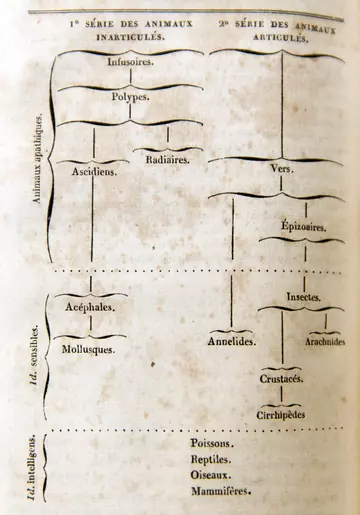
Darwin's theory
The first edition of On the origin of species by natural selection .... by Charles Darwin and published in 1859, contains this tree of life:
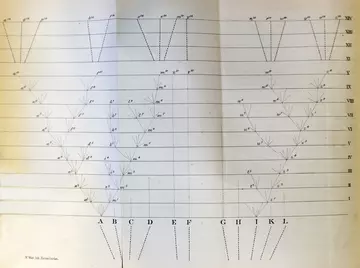
Darwin used the tree of life to explain his ideas about evolution, this extract is from page 129:

Haeckel's theory on evolution
Ernst Haeckel in his book the Evolution of man published in 1879, depicts this wonderful, gnarled tree of life illustrating evolution. Interestingly, he was a strong defender of Darwinism, his own published works on Darwinism were translated into many languages and it is though that more people learned about evolutionary theory from Haeckel than from Darwin. Haeckel and his wonderful illustrations for Art and Nature are featured in another of our blogs Extraordinary images by Ernst Haecke.
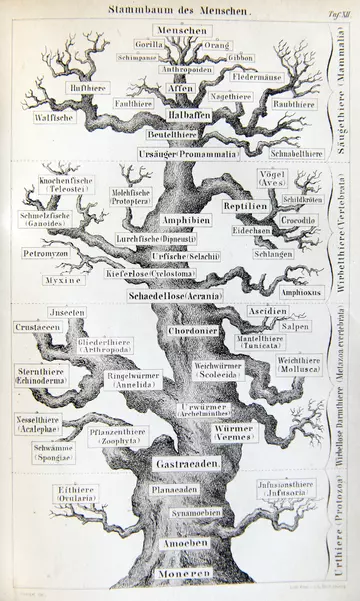
The relationships in trees of life were based on shared traits and inferences. In the 20th and 21st century the phylogenetic tree of life has become increasingly complex to illustrate owing to the large amounts of genomic data. Attempts were made to depict them in many various ways but now along with the development of computers we can have explore interactive trees of life. At a recent ZSL Science and Conservation event celebrating 'Ten years of the EDGE of Existence', Dr Yan Wong and Dr James Rosindell described the OneZoom tree of life, an interactive tree of life, which is now possible owing to the development of computers. This is amazing and I am sure Charles Darwin if alive today would be so excited by this tree of life and the possibilities for its use. Listen to their talk and view their slides here. This tree of life has been used in the development of ZSL’s EDGE (Evolutionary Distinct and Globally Endangered) of Existence.
These developing ways of depicting phylogenetic data help us to understand life on earth and ZSL’s mission to promote and achieve the worldwide conservation of animals and their habitats.
Some further reading, books mentioned in the blog and some additional depictions of trees of life – all these items are in ZSL Library.
Animal taxonomy by Theodore Savory, London: Heinneman, 1970. (On page 28 shows a classification of the animal kingdom designed in the form of a set of shelves.)
Anthropogenie oder Entwickelungsgeschichte des Menschen, Ernst Haeckel, Leipzig, Engelmann, 1874
Evolution emerging : a survey of changing patterns from primeval life to man by William King Gregory, New York : Macmillan, 1951
The global diversity of birds in space and time by W. Jetz et al, Nature, 15 November 2012, Vol. 491 No. 7424, pp. 444-448 (On page 446 there is a colourful circular depiction of the avian tree) doi:10.1038/nature11631
Handbuch der Zoologie, von Georg August Goldfuss, Nürnberg : Schrag, 1820. (An egg shaped system)
Histoire naturelle des animaux sans vertèbres, presentant les caractères généraux et particuliers de ces animaux, leur distribution, leurs classes, leurs familles, leurs genres, Tome , 2nd ed. par J.B.P.A. Lamarck et al, Paris, London : Bailliere, 1835
Horae entomologicae, or, essays on the annulose animals by W.S. Macleay, London : Bagster, 1819-21(In which the Quinarian Classification system is described)
Observations on the natural affinities that connect the orders and families of birds by Nicholas Aylward Vigors, Transactions of the Linnean Society, 1825, Vol. 14, pp. 395-517 (Quinarian system as applied to birds)
On the origin of species by means of natural selection, .., by Charles Darwin, London : Murray, 1859
Recherches sur les poissons fossiles. . . par Louis Agassiz, Tome I, Neuchatel : Petitpierre, 1833-44 (Genealogy of the class of fish)
Time, life and man: the fossil record by R. A. Stirton, New York : John Wiley ; London : Chapman & Hall, 1959
Trees and networks before and after Darwin, by Mark A. Ragan, Biology Direct20094:43. https://biologydirect.biomedcentral.com/articles/10.1186/1745-6150-4-43
